Olmsted County Plans Future Materials Recovery Facility
Most people's understanding of the recycling process ends at the curb. Materials that are out of sight are usually out of mind. But curbside collection is just the beginning of a long journey that sees recyclable materials consolidated at local transfer stations, loaded onto trucks, and shipped to Twin Cities Materials Recovery Facilities (MRFs).
MRFs are high-tech facilities where humans and machines work together to sort out the items we toss into our recycling carts. This video by Dem-Con Materials Recovery does a great job of showing how a MRF operates.
After sorting, recyclables are sent on to regional brokers or mills to be made into new products.
 A rendering of the proposed MRF connected to the Olmsted Waste-to-Energy Facility via RRT Design & Construction
Olmsted County hopes to create a local destination for recyclable materials in the coming years. Our department, with the support of the Olmsted County Board of Commissioners, is advocating for the creation of a MRF on the south side of the Olmsted Waste-to-Energy Facility.
MRF Benefits
Provide a Local Destination for Recyclable Materials
It's important to note that the further recyclables have to travel, the less "green" the recycling process becomes. In other words, shortening the distance from curbside collection to a MRF would increase the environmental benefit of recycling. Providing a local destination for recyclable materials will significantly reduce the amount of fuel, time, and money required to sort out the items we toss in our curbside recycling carts.
 A rendering of sorting lines within the proposed MRF via RRT Design & Construction
Delay OWEF Expansion
In addition to providing a much closer location for the sorting of regional recyclables, the MRF would contain equipment to clean garbage (fuel) before it is processed in the waste-to-energy facility. All garbage in Olmsted County is brought to the Olmsted County Integrated Solid Waste Management System with the majority being processed through the Olmsted Waste-to-Energy Facility (OWEF). Garbage processed at the OWEF is used to produce energy in the forms of steam and electricity.
The fuel-cleaning equipment of a MRF would remove materials (like glass, metal, and potentially organics) that take up space, add little to no energy value, and create extra wear and tear on the facility. Removing these materials would also free up capacity to process non-recyclable waste.
As a result, the need for an expansion of the OWEF—a project that would be far more costly than the addition of a MRF—could be significantly delayed or possibly prevented altogether.
Please note: the addition of fuel-cleaning technology would NOT be a substitute for correct recycling habits at the curb. We will still need residents to place the proper items in their garbage bins and recycling carts.
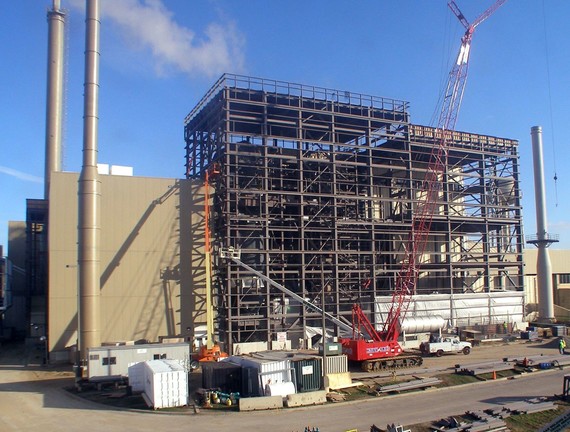 Unit 3 of the Olmsted Waste-to-Energy Facility under construction in 2008; Photo Credit: Olmsted County Staff
Delay Further Ash Landfill Expansion
There is a direct correlation between the amount of waste processed at the OWEF and the amount of ash sent to the Kalmar Landfill. By removing glass, non-magnetic metal, and possibly organic material from the garbage, we slow the rate at which we fill ash cells.
 A bulldozer pushes ash at the Kalmar Landfill; photo credit: Anthony Wittmer
Cleaner Fuel and Reduced Ash Metal Extraction
Currently, we remove some ferrous (magnetic) metal from ash when it arrives at the Kalmar Landfill. The MRF would sort ferrous and non-ferrous metals out of the garbage prior to the combustion process and thus capture a larger percentage. This would improve fuel quality, resulting in decreased maintenance expenses, increased uptime, and increased energy (steam and electrical) production. This would also simplify the disposal process for ash once it arrives at the Kalmar Landfill.
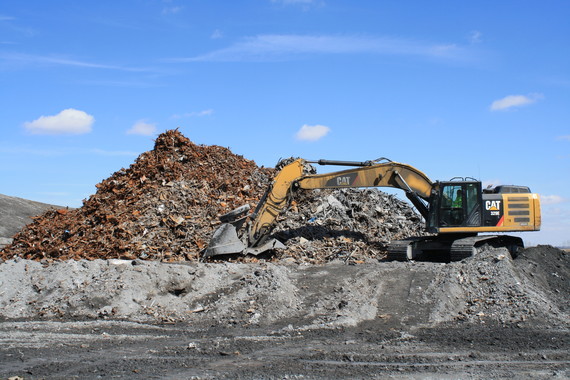 An excavator uses a magnet to pull ferrous metals from the ash at the Kalmar Landfill; photo credit: Anthony Wittmer
Potential Timeline
-
June 2021 | Olmsted County submits an application for $12.5 million in MN State Bonding
-
January 2022 | This project makes Governor Walz's budget (hopefully)
-
January 2022 | Begin MRF permitting pre-design
-
October 2022 | Receive notice of award for state funding (hopefully)—approval required by state legislature
-
January 2023 - August 2024 | MRF construction design permitting bidding
-
February 2024 - March 2025 | MRF construction
-
April 2025 | MRF becomes operational
Stop by our Booth at the Olmsted County Fair July 26 - August 1
The Olmsted County Free Fair runs July 26 - August 1. As in past years, the Environmental Resources Department will host an educational booth in the Conservation Building throughout the week.
Stop by to learn about the proper place for your waste in Olmsted County. The Conservation Building is located in the northeast corner of the fairgrounds at the intersection of 14th St SW and Fairgrounds Ave SE.
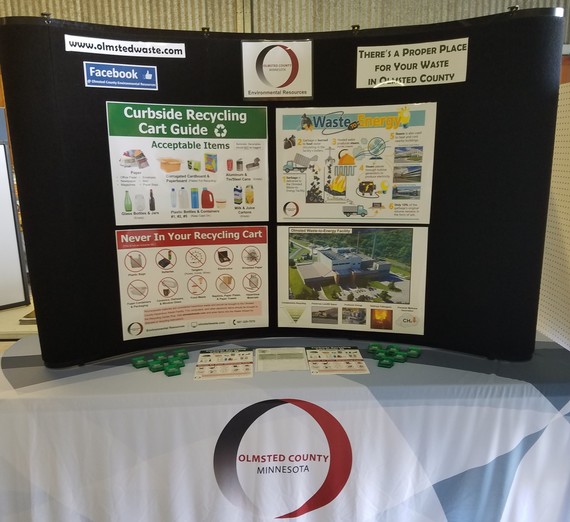 Olmsted County Environmental Resources Department Fair Booth; photo credit: Anthony Wittmer
Kalmar Landfill Ash Cell Expansion Project
Most of the waste brought to the Olmsted County Kalmar Landfill comes in the form of ash from the Olmsted Waste-to-Energy Facility (OWEF) and is deposited in an ash cell. This past spring, work began on closing Ash Cells 3 and 4 as they had reached their holding capacity. Simultaneously, work began on creating a new ash cell—cell 6.
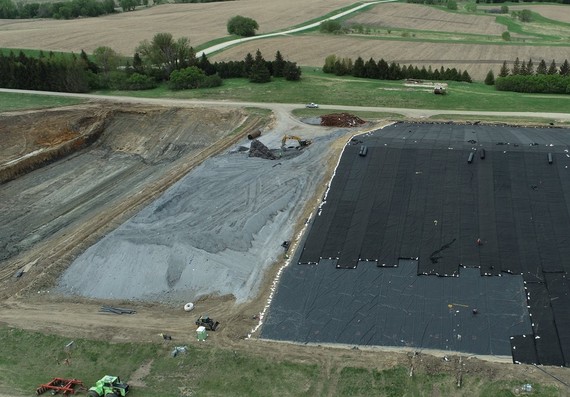 Photo taken in May - from left to right, Ash Cell 6 under construction, Ash Cell 5 in operation, & Ash Cells 4 and 3 being capped/closed; photo credit: Olmsted County Surveying Staff
The ash cells at the Kalmar Landfill are engineered to effectively contain waste and preserve groundwater quality. Each ash cell consists of:
- A leachate collection system
- A 60-millimeter high-density polyethylene (HDPE) plastic liner
- A 2.5-foot compacted clay barrier layer
- Another 60-millimeter HDPE plastic liner
- An additional 3-foot compacted clay barrier layer
Water (from rain events) that percolates through ash will be captured in a leachate collection system. Leachate is pumped out and brought to the Water Reclamation Plant in Rochester for treatment.
Each cell is approximately 200 feet wide by 600 feet long. At current rates of disposal, Cell 5 and newly constructed Cell 6 will have the capacity to accept ash for the next seven to eight years.
As it exists today, the Kalmar Landfill is permitted to add four more cells for a total of ten. This would see the ash cells' available capacity used up sometime in the mid-2050s. However, potential projects on the horizon including the MRF and ash utilization (topic for another newsletter) could prolong the useful life of the ash cells by several decades.
The current ash cell expansion project is moving along on schedule and should be completed by early September.
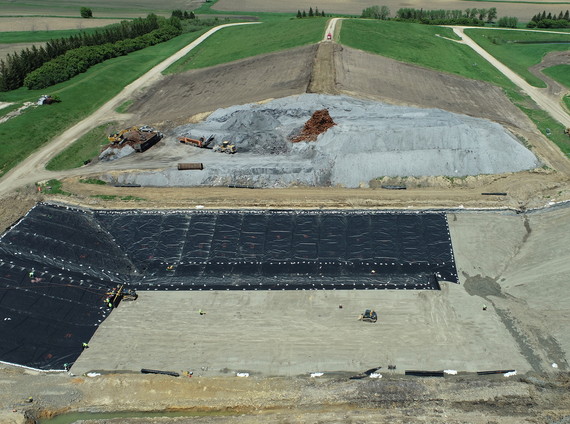 Photo taken in June - from bottom to top, Ash Cell 6 under construction, Ash Cell 5 in operation, & Ash Cells 4 and 3 being capped/closed; photo credit: Olmsted County Surveying Staff
Olmsted County and Rochester Public Utilities Seeking Nominations for Environmental Achievement Awards
The Olmsted County Environmental Commission and Rochester Public Utilities (RPU) are seeking nominations for the 2021 Environmental Achievement Awards. The awards honor individuals, organizations, schools, and businesses that have made a significant environmental contribution over the past year in Olmsted County.
Award categories include climate change, education, renewables, sustainable food production, conservation, energy, water, and "other."
Since 1992, the awards have recognized the positive environmental impact of over 100 Olmsted County community members and groups.
Visit our website to download a nomination form and to see previous award winners. Completed nominations are due by Friday, October 1, 2021, to Anthony Wittmer—wittmer.anthony@co.olmsted.mn.us.
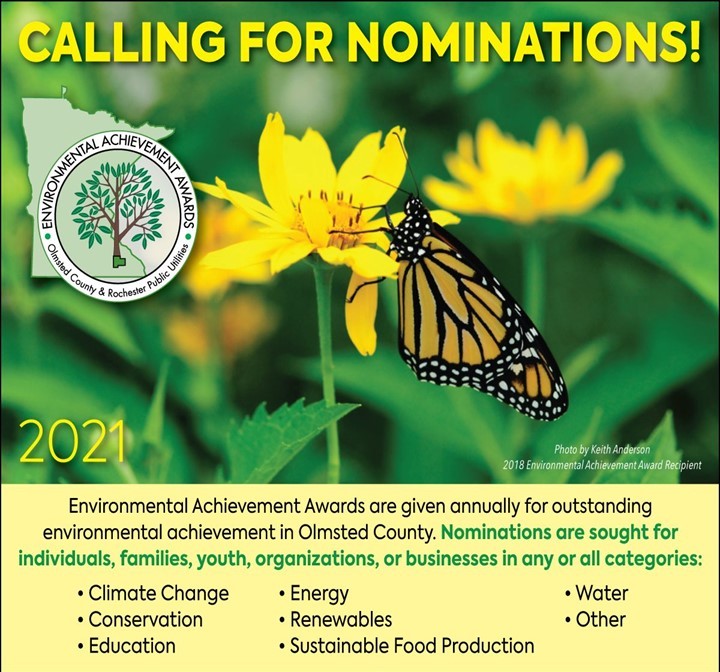
Household Hazardous Waste Mobile Collections Resume for 2021
Household Hazardous Waste Mobile Collections have resumed in 2021. This year's collection event schedule (for Olmsted County) has been updated:
Eyota-Dover
Tuesday, July 27 | 4:00 p.m. - 6:00 p.m.
High School East Parking Lot
615 South Ave, Eyota, MN 55934
Stewartville
Tuesday, August 10 | 3:00 p.m. - 6:00 p.m.
St. John's Lutheran Church
111 2nd Ave NE, Stewartville, MN 55976
Byron
Tuesday, August 24 | 3:30 p.m. - 6:00 p.m.
Byron Fire Hall
707 Frontage Rd NW, Byron, MN 55920
Chatfield
Tuesday, September 14 | 3:00 p.m. - 6:00 p.m.
Chatfield City Garage
Alley off Main St. between 3rd & 4th St., Chatfield, MN 55923
Oronoco
This collection—typically held in early May—was postponed due to the COVID-19 pandemic. We will be posting the rescheduled date/time on our website once that information has been confirmed.
A full list of acceptable and unacceptable items can be found on our website.
Please Note: Any items accepted at mobile collection events can also be brought to the Olmsted County Hazardous Waste Facility for FREE.
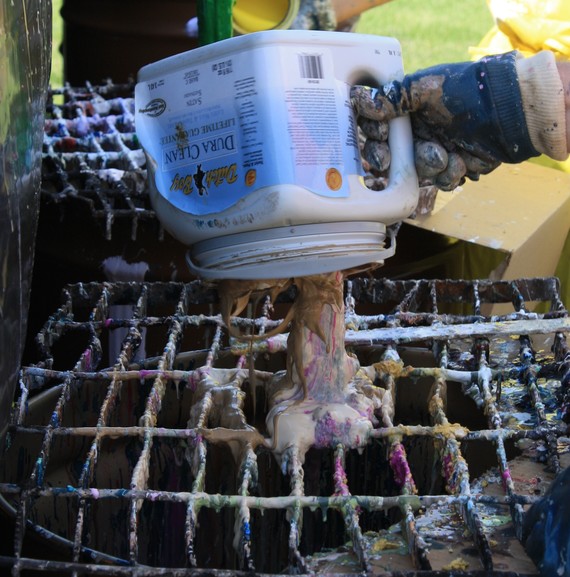 Paint is collected at a Household Hazardous Waste Mobile Collection; photo credit: Anthony Wittmer
Disposal Discussion: Single-Serve Plastic Coffee Pods
Throw single-serve plastic coffee pods in the garbage even if they are marked with a #1, #2, or #5 resin identification code. They are so small, that equipment at Materials Recovery Facilities (MRFs) cannot properly sort them and they end up contaminating other recyclable items.
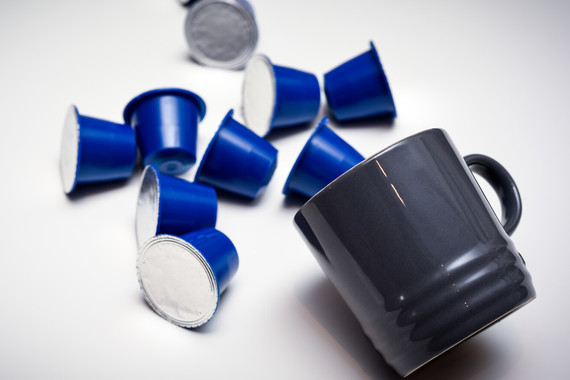
|